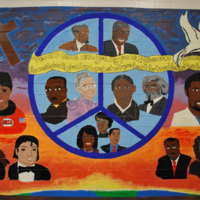
Saint Sabina Mural
In 2011, Chicago-based muralist Lavernon Spivey painted a mural with Howard University students at the Saint Sabina Catholic Church in Chicago’s southside. The mural depicts African American heroes both local and national, past and present, including the antislavery figures Frederick Douglass Harriet Tubman, and also Mae C. Jemison, Barack Obama, Harold Washington, Martin Luther King Jr., Michael Jackson, Michelle Obama, Rosa Parks and Shirley Chisholm. The mural also includes a passage form John 14:27 that reads, “Peace I leave with you, my peace I give unto you not as the world giveth, give I unto you, let not your heart be troubled, neither let it be afraid.”
![Nelson Stevens, Centennial Vision, Tuskegee University Administration Building, AL, 1980 [destroyed].jpg.gif Nelson Stevens, Centennial Vision, Tuskegee University Administration Building, AL, 1980 [destroyed].jpg.gif](https://486312.frmmmguz.asia/files/square_thumbnails/1a0ef8af8ec25559e5c2c7c66502ba40.jpg)
Centennial Vision
In 1980, on the anniversary of the founding of the Tuskegee Institute, AfriCOBRA member Nelson Stevens created a mural to celebrate the occasion. Although Stevens was commonly an exterior mural painter, he created this mural on the inside of the Tuskegee University Administration Building. The mural contains the images of black history figures such as Booker T. Washington (former president of Tuskegee University), General Chappie James and the Tuskegee airmen of World War II, Cinque, Malcolm X, Martin Luther King Jr., and George Washington Carver, as well as the antislavery figures Harriet Tubman, Sojourner Truth and Frederick Douglass. Also included in the image is a phrase made famous by the African scholar John S. Mbiti, “I Am Because We Are.” This mural no longer exists.
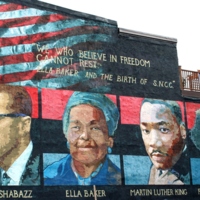
Freedom School
In 2002, with support from the Freedom School Mural Arts Project, Parris Stancell created a mural in West Philadelphia titled Freedom School. The mural sets the faces of Malcolm X, Ella Baker, Martin Luther King Jr., and Frederick Douglass against the backdrop of the American and Black Liberation flags. It depicts Douglass in his younger years, and refers to Malcolm X as Malcolm Shabazz – a composite of his names in the latter years of his life; Malcolm X and el-Hajj Malik el-Shabazz. The mural also champions women's activiism through Ella Baker’s quotation, “We who believe in freedom cannot rest.”
![Anonymous, West 116th Street at 8th Ave, Harlem, NYC, 2007 [destroyed].jpg Anonymous, West 116th Street at 8th Ave, Harlem, NYC, 2007 [destroyed].jpg](https://486312.frmmmguz.asia/files/square_thumbnails/68ba2c99969cfee543cc2473ef6ae0da.jpg)
If There is No Struggle
This mural was painted by an anonymous artist around 2007 and no longer exists, but is an important example of both the ephemeral and guerrilla nature of murals: some last for short periods of time on buildings and streets in communities. This particular mural was created in West Harlem and focused on the abolitionist Frederick Douglass. Borrowing his famous phrase from 1857, “If there is no struggle, there is no progress,” the muralist also adds a drumming figure to the centre of the mural.
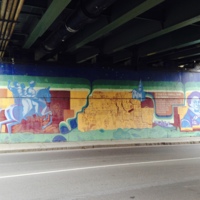
Tubman and Douglass
In 2010 the Brooklyn-based muralist Jonathan Matas created a mural on Green Street in Ithaca under the Aurora Street Bridge. The 30 x 600 foot mural was approved by the Public Arts Commission and depicts Frederick Douglass and Harriet Tubman. “I think it’s a great introduction to our city,” Ithaca Planning and Development Director JoAnn Cornish said. But this was not the general consensus around the mural. The name, 'Comrade Tubman' given to Harriet Tubman on the mural has been a point of controversy for the local community. Tompkins County historian and author Carol Kammen observed: “The word comrade is historically inappropriate and anachronistic."
![Marianne DiNapoli-Mylet, Looking Back, A History of the Black Press, 617 Liberty Street [Chronicle building], Winston-Salem, NC, 1998.jpg Marianne DiNapoli-Mylet, Looking Back, A History of the Black Press, 617 Liberty Street [Chronicle building], Winston-Salem, NC, 1998.jpg](https://486312.frmmmguz.asia/files/square_thumbnails/e0cc2766c734172616139639b01f1af0.jpg)
Looking Back, A History of the Black Press
In 1998, Ernie Pitt, the editor of the Winston-Salem Chronicle, requested a mural that depicted the black press in the United States. Responding to his request, muralist Marianna DiNapoli-Mylet, created Looking Back, A History of the Black Press on the Winston-Salem Chronicle building, In the mural, she shows the history of the black press from 1700 through to the 1960s. The mural features Frederick Douglass most prominently in the centre, with other individuals including W.E.B. Du Bois on the periphery.
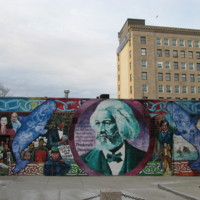
Labor History Mural
This mural in New Bedford titled Labor History Mural and painted by Irish muralist, Dan Devenny, is a short distance away from where Frederick Douglass first lived in freedom. It is on a wall near the Bristol County Probate Court.On September 18, 1838, Douglass settled here in New Bedford after escaping from slavery in Maryland, with the help of his soon-to-be wife, Anna Murray. It was in New Bedford where Douglass experienced, for the first time, what it was like to live as a free man. His abolitionist identity started to take shape. He read his first copy of The Liberator, became a licensed preacher, gave a speech in 1839 that denounced the proposal that free slaves be forced to emigrate back to Africa, and was hired as an agent by the Massachusetts Anti-Slavery Society (MASS). In 1841, after attending a regional convention for the followers of William Lloyd Garrison, Douglass felt compelled to speak about his time in bondage. Inspiring the Garrisonian audience, he was shortly recruited as a lecturer for MASS. “Many students in New Bedford never learn of the importance of Frederick Douglass and his relation to the civil rights movement and this city,” said Massachusetts Senator Mark Montigny. “This mural will be a constant reminder of his prominent leadership and what he means to New Bedford.”
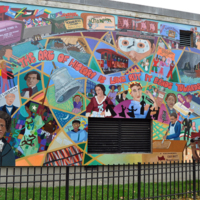
The Arc of History is Long
The muralist David Fichter adapted Martin Luther King Jr.’s famous quotation “the arc of the moral universe is long but it bends towards freedom,” for this 2002 mural in Cambridge, Massachusetts. The mural features Susan B. Anthony, Rosie the Riveter, William Lloyd Garrison and W.E.B. Du Bois, as well as a young Frederick Douglass.At around the same age as he appears in this mural, Douglass gave a speech in nearby Boston on February 8, 1855 where he drew attention to the psychological impact of enslavement: “Whipping is not what constitutes the cruelty of Slavery," explained Douglass. “To me the thought that I am a slave is more terrible than any lash, than any chain.”
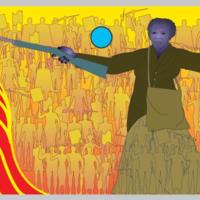
The Dreams of Harriet Tubman
In 2000, muralist Mike Alewitz planned on creating a series of murals about the heroes of the abolitionist movement, titled The Dreams of Harriet Tubman. Alewitz’s goal was to have the Dreams series as a necklace of murals across the state of Maryland with the flagship mural on a major wall in the city of Baltimore. This mural would depict Harriet Tubman, who was also known as Moses. In a pre-circulated plan on Black Radical Congress General News, Alewitz described how the flagship mural would have an army of freedom fighters (Martin Luther King Jr., Malcolm X, Mumia Abu Jamal, Sojourner Truth and Robert Gould) standing behind a musket-wielding Tubman. But the mural stirred up controversy when the group who had planned to display the mural, the Associated Black Charities Inc., decided the piece could be construed as racist and violent. Alewitz was asked to replace the musket but he refused: “I will not disarm Harriet Tubman. I won’t take [the musket] out of her hands.” The lack of a major wall was a setback for the Dreams series and another of the murals, on a wall in Hartford County, was defaced in the summer of 2000 by racist graffiti.
![Curtis Lewis, African Amalgamation of Ubiquity, 9980 Gratiot Avenue, Detroit, Michigan, 1985 [destroyed in 2013].jpg Curtis Lewis, African Amalgamation of Ubiquity, 9980 Gratiot Avenue, Detroit, Michigan, 1985 [destroyed in 2013].jpg](https://486312.frmmmguz.asia/files/square_thumbnails/3ac63b31ad894031e7c74b99651ace4a.jpg)
African Amalgamation of Ubiquity
In 1985, muralist Curtis Lewis created a mural on the side of a drug rehabilitation centre on Gratiot Avenue, Detroit, Michigan. The building belonged to Operation Get Down and included the antislavery figures Frederick Douglass and Harriet Tubman, as well as Malcolm X, Mary McLeod Bethune, Jesse Jackson, Thurgood Marshall, Martin Luther King Jr., W.E.B. Du Bois, Booker T. Washington, Ida B. Wells, Marcus Garvey and Nelson Mandela, alongisde Egyptian, Nubian and pharaoh figures. The man who breaks free of his chains in the centre of the mural holds a sign that reads, “Behold my people, arise, stand strong and proud, for ye come from pharaohs, emperors, kings and queens.” The mural was destroyed in 2013.
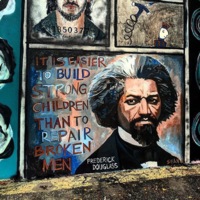
Strong Children
Painted by Charleston-based artist Sean Williams, this mural depicts the antislavery leader Frederick Douglass in the younger phase of his life, and uses his statement from in 1855, “It is easier to build strong children than to repair broken men.” The mural is in a church parking lot in Charleston, South Carolina.
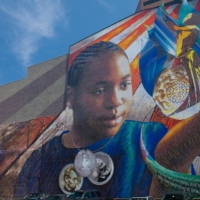
Lincoln Legacy
This large mural by Joshua Sarantitis, Lincoln Legacy, can be read from left to right, moving from Africa to America. The shape of Africa adorns the backdrop until the wooden boards of the slave ship transform into the American flag. Around the young child’s neck are three medallions: Abraham Lincoln’s face, Josiah Wedgwood’s abolitionist icon “Am I Not a Man and a Brother,” and Frederick Douglass' face. Made up of over 1 million glass mosaic tiles, it is the largest Venetian glass tile mural in Philadelphia at over 10,000 square feet. Located a block away from the Liberty Bell and Independence Mall, it is one of the few murals to be created in Philadelphia’s wealthier districts.
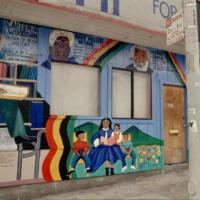
Scenes from the Bayview Opera House
Painted in 1995 in San Francisco by artist Leboriae P. Smoore, this mural acts as a children’s textbook in the street, teaching about the antislavery leaders Harriet Tubman and Frederick Douglass, and other black figures: Carter G. Woodson, Mary McLeod Bethune, W.E.B. Du Bois, Ida B. Wells, and Jackie Robinson.
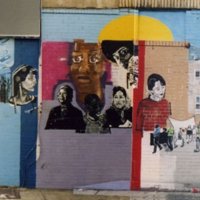
Women Warriors
In 2001, Brooklyn-based muralist Leola Bermanzohn created a mural in the Flatbush area of Brooklyn titled Women Warriors. Bermanzohn works as a muralist for the Groundswell organisation, launched in 1996 with the mission of bringing together artists, youth and community organisations to create murals that beautify local neighbourhoods and give expression to underrepresented ideas and perspectives. Women Warriors was created in collaboration with Sister Outsider – an organisation run by and for women of colour that aimed to help women enter the professional world of work and operate in the political realm. The mural was at the organisation’s headquarters and depicted antislavery leaders Harriet Tubman and Sojourner Truth as well as Nefertiti, Rosa Parks and Assata Shakur, alongside a poem written by Audre Lorde. It had been destroyed by 2015.
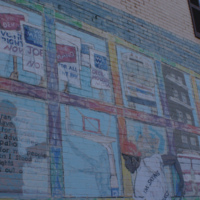
The Dignity of Work
In 1989, muralist Alfred Smith painted a mural in Anacostia, D.C., near Frederick Douglass’ residence during the last years of his life. It depicted the silhouette of Douglass alongside scenes from a labour protest. The mural, titled The Dignity of Work, contains a quotation from a speech by Douglass in 1888 before the International Council of Women. The mural had been destroyed by 2016.
![Cletus Alexander, Frederick Douglass Inspiring the Youth of the Negro Race, MacFarlane Middle School, Dayton, OH, 1933 [now in Dayton Art Institute] (2).jpg Cletus Alexander, Frederick Douglass Inspiring the Youth of the Negro Race, MacFarlane Middle School, Dayton, OH, 1933 [now in Dayton Art Institute] (2).jpg](https://486312.frmmmguz.asia/files/square_thumbnails/25a4cf3110ae30cf50088118e9193e7b.jpg)
Frederick Douglass Inspiring the Youth of the Negro Race
In 1933, Cletus Alexander, a student at Dayton Art Institute, submitted designs for a mural titled Frederick Douglass Inspiring the Youth of the Negro Race. Douglass is depicted as a biblical, Moses-like figure with flowing hair and a white beard, wearing traditional red and white robes. Towards the top of the mural are the words from Langston Hughes’ poem, Youth: “We have to-morrow, Bright before us, Like a flame, yesterday a night-gone thing, A sundown name, And dawn today, Broad arch above the road we came, we March!” At the time the mural was painted, it was housed in the MacFarlane Middle School building. After that building was destroyed in 2005, it was removed, restored, and is housed in the Dayton Art Institute.
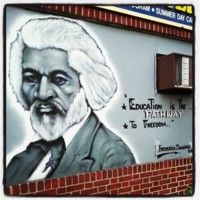
Educational Mural
This mural was painted in the Bronx, New York City by an unnamed artist and depicts Frederick Douglass in the later years of his life, and the phrase "Education is the pathway to freedom." it had been destroyed by 2016.
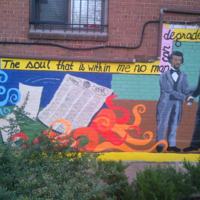
Frederick Douglass Recreation Center Mural
Painted in 2012 by MTC Studio, the mural depicts the black abolitionist Frederick Douglass shaking hands with President Abraham Lincoln. An older version of Douglass is offset to the right side of the mural. The mural site is adjacent to the Frederick Douglass National Historic Site in Anacostia, Washington D.C.
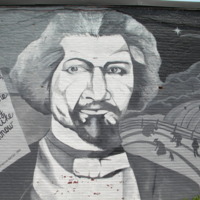
Frederick Douglass
In 1860, Frederick Douglass took to the stage at Boston's African Meeting House to give his speech, “A Plea for Free Speech in Boston.” Muralists Deborah Browder and Heidi Schork transcribed words from the speech onto their mural at Hammond and Tremont Street. “Liberty is meaningless when the right to utter one’s thoughts and opinions has ceased to exist,” Douglass pronounced in 1860. Three years later, in the same Meeting House on Joy Street, Beacon Hill, African American soldiers, including two of Douglass’ sons, were recruited into the Fifty-fourth Regiment of the Massachusetts Infantry under the leadership of Colonel Robert Gould Shaw.
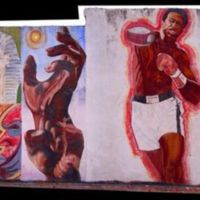
Wall of Respect
Borrowing its name from the 1967 “Wall of Respect” of Chiacgo, muralists Ashanti Johnson, Nathan Hoskins and Verna Parks installed their own public artwork in Atlanta. The abolitionist Frederick Douglass is alongside Martin Luther King Jr., Malcolm X and W.E.B. Du Bois, with the North Star between them. Angela Davis and Muhammad Ali are also present. The mural was destroyed in 2007.